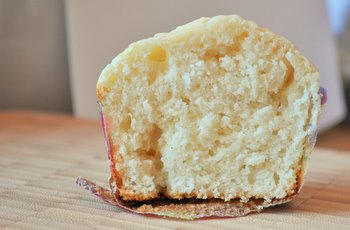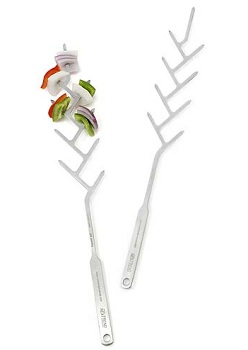
In baking, the term “tunneling” refers to tunnels and very large air pockets that form inside of muffins and quick breads as a result of overmixing a batter. The muffin pictured above gives you an idea of what tunneling looks like. Generally, you want muffins, cakes and cupcakes to be fairly uniform in texture. This muffin features large tunnels in the bottom left and top right corners in the photo, and a large air pocket at the top. I’ve seen cakes with far more tunnels than this, but this gives you an idea of what to look for.
Over-mixing causes tunneling because it causes more gluten to develop than you really need. Unlike a bread dough, you don’t need complex networks of gluten to help trap the air as your bread bakes; a small amount that is generated with just enough mixing tends to work best. Over-mixed muffins don’t look quite as attractive as other muffins, but they are also tougher and don’t keep quite as well (the toughness becomes even more pronounced over time). Just about any muffin or cake batter can be over-mixed – even pancake batter, leading to tough pancakes – but low fat recipes are especially vulnerable because there isn’t much fat to inhibit gluten formation. Higher fat recipes, such as cookies and some rich cakes, almost never have tunneling problems. That said, a careful hand when mixing should ensure that you’ll never have a problem.
The best way to avoid over-mixing is to follow the directions of a recipe carefully, only mixing “until no streaks of dry ingredients remain” or “just until all ingredients are incorporated.” You are more likely to over-mix with an electric or stand mixer, because they tend to get more mixing in in a short time when you compare it to stirring by hand (and because often people will simply walk away while their mixer is on!). Finally, take a look at the muffins and cakes that you bake. If you notice a lot of tunneling, then be a little more careful with your mixing and you’ll have a more tender finished product in the end.






Debbie m
June 3, 2011Thanks for this information! It’s nice to know why we’re not supposed to overmix quick breads and how to tell if we have.
Alexandra
July 9, 2013Hi Nicole,
Occasionally, I’ll make a quick bread that ends up with holes like the muffin pictured above, even though I’m careful to only mix the dry with the wet just until I can’t see the dry anymore. What’s your opinion on this? Do you think the recipe needs more moisture so that the dry can mix into the wet easier and faster? Or is it a matter of folding technique?